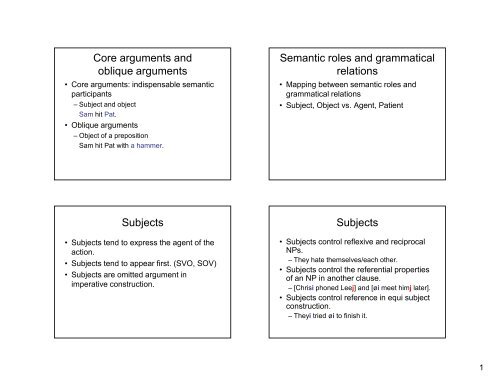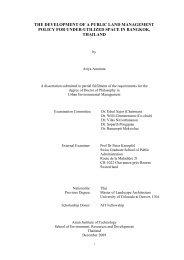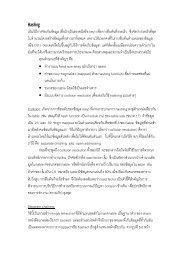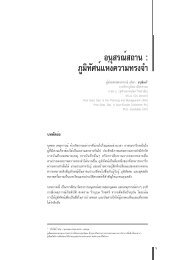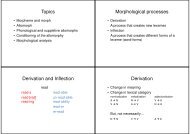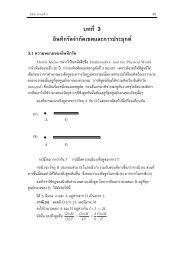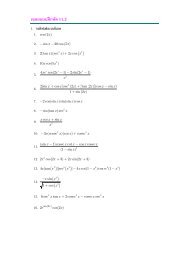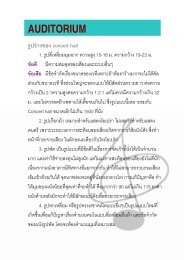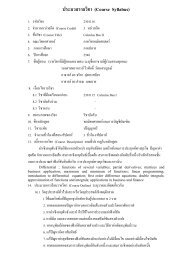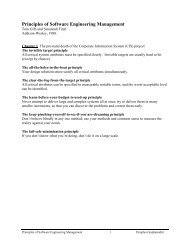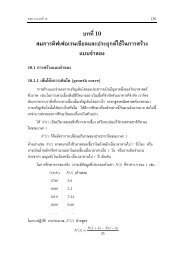Core arguments and oblique arguments Semantic roles and ...
Core arguments and oblique arguments Semantic roles and ...
Core arguments and oblique arguments Semantic roles and ...
Create successful ePaper yourself
Turn your PDF publications into a flip-book with our unique Google optimized e-Paper software.
<strong>Core</strong> <strong>arguments</strong> <strong>and</strong><br />
<strong>oblique</strong> <strong>arguments</strong><br />
• <strong>Core</strong> <strong>arguments</strong>: indispensable semantic<br />
participants<br />
– Subject <strong>and</strong> object<br />
Sam hit Pat.<br />
• Oblique <strong>arguments</strong><br />
– Object of a preposition<br />
Sam hit Pat with a hammer.<br />
<strong>Semantic</strong> <strong>roles</strong> <strong>and</strong> grammatical<br />
relations<br />
• Mapping between semantic <strong>roles</strong> <strong>and</strong><br />
grammatical relations<br />
• Subject, Object vs. Agent, Patient<br />
Subjects<br />
• Subjects tend to express the agent of the<br />
action.<br />
• Subjects tend to appear first. (SVO, SOV)<br />
• Subjects are omitted argument in<br />
imperative construction.<br />
Subjects<br />
• Subjects control reflexive <strong>and</strong> reciprocal<br />
NPs.<br />
– They hate themselves/each other.<br />
• Subjects control the referential properties<br />
of an NP in another clause.<br />
– [Chrisi phoned Leej] <strong>and</strong> [øi meet himj later].<br />
• Subjects control reference in equi subject<br />
construction.<br />
– Theyi tried øi to finish it.<br />
1
Relationships within the clause<br />
• Word order (constituent order)<br />
• Agreement (cross-referencing)<br />
• Case marking<br />
Not mutually exclusive<br />
Word order<br />
• The order of subject, object <strong>and</strong> verb<br />
• Subjects are made distinct from objects by<br />
appearing in a fixed position.<br />
• SVO, SOV, VSO, VOS, OVS, OSV<br />
• Basic word order vs. marked order<br />
Word order<br />
• SVO <strong>and</strong> SOV – most frequent<br />
• Two generalizations<br />
– Subject-initial order<br />
– V adjacent to O<br />
• Head-initial vs. head-final<br />
– VO vs. OV<br />
Agreement or cross-referencing<br />
• A verb is marked to reflect properties of its<br />
NP <strong>arguments</strong>.<br />
– Person, number, gender<br />
2
Agreement<br />
• No agreement<br />
• Agree with some of its <strong>arguments</strong><br />
French<br />
Nous avons mangeɴ des pommes.<br />
we have:1PL eaten INDEF PL apples<br />
‘We have eaten apples.’<br />
• Agree with all of its <strong>arguments</strong><br />
Inuktitut (Allen <strong>and</strong> Schröder 2003)<br />
Qukiq-si-gakkit<br />
shoot-prospective aspect-causative1st person singular subject-<br />
2nd person singular object<br />
‘(I)’m shooting (you).’<br />
Agreement<br />
• If a language has object agreement, it also<br />
has subject agreement.<br />
Case systems<br />
• Relationship between verbs <strong>and</strong> <strong>arguments</strong> is<br />
indicated by case marking.<br />
• Case is usually marked on the head noun.<br />
Japanese<br />
Kodomo-ga hon-o yon-da<br />
child-NOM book-ACC read-PAST<br />
‘The child read the book.’<br />
Case-marking systems<br />
• The need to code semantic <strong>roles</strong><br />
• The need to code pragmatic function<br />
• The need to code transitivity<br />
German<br />
Der gross-e Hund knurrte<br />
the-NOM big-NOM dog growled<br />
‘The big dog growled.’<br />
3
Active-stative system<br />
• Three-way distinction in Chickasaw:<br />
Agent, Patient, Dative<br />
• Two-way distinction in Seneca: Agent,<br />
Non-agent<br />
Nominative-accusative system<br />
• Nominative <strong>and</strong> accusative<br />
– He hit him.<br />
– He ran.<br />
• However, grammatical relations can still<br />
play a role.<br />
Ergative- absolutive system<br />
• Dixon (1972, 1979, 1994): S, A, O<br />
• Ergative <strong>and</strong> absolutive<br />
– He hit him.<br />
– Him ran.<br />
Ergative language<br />
Basque<br />
Gixona-k liburua erosi dau<br />
man: ERG book:ABS buy AUX:3SG<br />
‘The man (A) has bought the book (O).’<br />
Gixona etorri da<br />
man:ABS come AUX:3SG<br />
‘The man (S) has come.’<br />
Gixona ikusi dot<br />
man:ABS see AUX:1SG<br />
‘I (A) have seen the man (O).’<br />
4
Split ergative<br />
• Ergative case marking for some<br />
constructions <strong>and</strong> accusative case<br />
marking for others.<br />
– Dyirbal: nouns have ergative case marking;<br />
1 st <strong>and</strong> 2 nd person pronouns have accusative<br />
case marking.<br />
Grammatical relations in ergativeabsolutive<br />
system<br />
• It is not uncommon for a language with<br />
ergative case-marking to show accusative<br />
syntactic patterns.<br />
• Warlpiri: ergative case marking, but<br />
accusative agreement pattern.<br />
• No language with accusative case marking<br />
<strong>and</strong> ergative agreement pattern<br />
• Accusative agreement pattern<br />
predominates cross-linguistically.<br />
Case systems<br />
• It is generally S that lacks any overt<br />
marking.<br />
• Case marking on accusative NP <strong>and</strong><br />
ergative NP<br />
Word order in languages with case<br />
marking<br />
Der Junge gab den Brief dem Lehrer.<br />
Den Brief gab der Junge dem Lehrer.<br />
Dem Lehrer gab der Junge den Brief.<br />
Der Junge gab dem Lehrer den Brief.<br />
‘The boy gave the letter (to) the<br />
teacher.’<br />
5
Case marking <strong>and</strong> agreement<br />
• Case marking can also be seen in verb<br />
agreement<br />
Sacapultec Maya (Du Bois 1987)<br />
s-ax-war-ek<br />
CMP-1pl.ABS-sleep-IF<br />
‘We slept.’<br />
6


